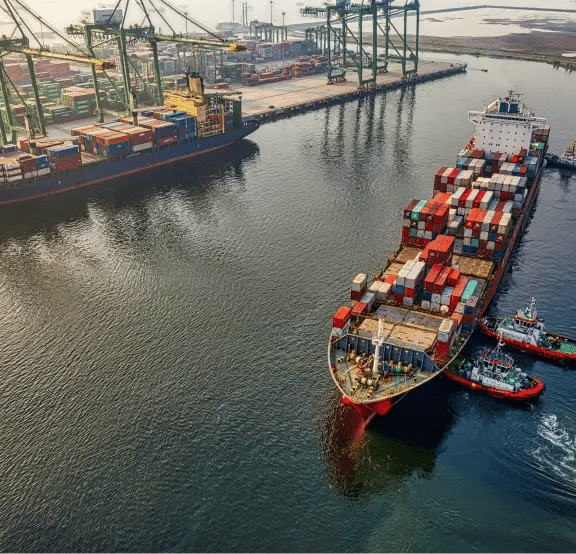The Geopolitics of Trade
Geopolitical dynamics are reshaping global trade through rising tensions, regional alliances, and shifting power structures. The U.S.-China "chip war" exemplifies how technological competition is influencing global supply chains. Regionalisation trends are forming new trade blocs, driven by both economic strategies and geopolitical imperatives. Conflicts in Europe and the Middle East further complicate the trade landscape, impacting energy supplies and trade routes. Chapter 2 explores how these geopolitical shifts are redefining trade networks, accelerating the shift towards bloc-based trade, and testing supply chain resilience.
New Alliances, New Trade Routes
Geopolitical challenges are currently posing significant obstacles to free and open trade, marking a departure from the relatively secure environment that supported trade growth over the past three decades. According to a survey of business leaders, geopolitical tensions, particularly between China and the United States, were identified as one of the primary challenges to trade growth.
Friendshoring and nearshoring are driving significant changes in supply chains
Accelerated by the COVID-19 pandemic and a rise in global crises, businesses are restructuring their supply chains to enhance resilience and minimise disruptions caused by conflicts, uncertainties, and policy changes.
Uncertainties Stemming from Global Political Elections
Significantly, more than 60 countries representing almost half of the world’s population will go to the polls in 2024. This has raised concerns about a rise in protectionist policies, not least in the United States. Economic nationalism is on the rise, and businesses will need to adapt.
See how your answer differs from those of 100+ business leaders.
US & China Relations
Relations between the United States and China are expected to remain precarious in the near-term as both countries grapple for control and influence, in particular over trade in technology and environmental goods. Ongoing tensions between both powers will have far-reaching implications for global trade and investment.
01 - Emergence of new production hubs to fill the China gap
Bilateral trade between the United States and China is expected to decline as both powers aim to disentangle their trade relationship. This decline has led to a shift in U.S. trade with other emerging markets, benefitting countries like Vietnam, Thailand, South Korea, and Mexico.
02 - Semiconductors poised to inflame U.S-China tensions
The battle for supremacy in semiconductors will become more prominent amid the U.S. and China chip war, with knock-on effects across industries and the green transition. However while the U.S. has taken proactive steps to reduce trade in semiconductors, the wider trade picture remains varied, with a surge in imports of Chinese laptops, phones, and toys since the COVID-19 pandemic.
03 - Technology and climate to emerge as new trade battlegrounds
The United States is actively working to curb Beijing's dominance in high-tech industries by promoting domestic innovation and focusing on sectors where it holds a competitive advantage.
04 - 2024 U.S. elections will test global trade growth
A Trump administration would likely revive the use of increased tariffs as a key component of U.S. trade policy, potentially reigniting a trade war with various partners. Recent indications suggest that Trump would consider imposing tariffs on China exceeding 60 percent.
What is The Future of The World Trade Organization?
Challenges to WTO
- Rising protectionism, geopolitical tensions, and evolving trade dynamics question the WTO's ability to facilitate international trade and resolve disputes.
- Criticisms during the Trump presidency highlighted concerns about the WTO's relevance and effectiveness in regulating modern trade issues.
- The WTO's dispute settlement mechanism has been hindered by the paralysis of its Appellate Body, limiting its enforcement capabilities.
- Urgent reforms are needed to enhance the WTO's responsiveness, authority, and adaptability to the changing global trade environment.

.webp?width=576&height=545&name=Frame%2071%20(1).webp)
Navigating modern challenges
- The WTO faces hurdles in promoting open and fair trade, as global crises have led to the introduction of protectionist policies by member countries.
- A significant number of subsidies and export restrictions have been implemented, posing risks to the global economy.
- The WTO has warned that protectionist measures could strip the global economy of 5% of its total income.
Recommendations for Business and Government
Business Recommendations
- Elevate geopolitical risk awareness. Geopolitical risk demands board and executive attention. Regular scenario planning involving key decision-makers helps anticipate developments and mitigate risks through effective contingency plans.
- Monitor economic security policies to maintain operational resilience. Businesses must monitor shifts in government policies and their impacts on operations amid growing economic security concerns. Analyse policy changes and adapt strategies to maintain operational resilience in response to both intended and unintended consequences.
- Communicate supply chain risks to key stakeholders. Engage proactively with authorities and stakeholders to communicate supply chain risks, contributing to informed trade policy decisions.
- Prepare for regulatory changes. Prepare for a protectionist regulatory environment by adapting operations to evolving regulations through restructuring or relocation.
- Regularly assess supply chain vulnerabilities. Regularly review supply chains for vulnerabilities and disruption risks, proactively addressing weak points and implementing mitigation strategies.
- Develop regional expertise and local intelligence. Understand diverse laws, regulations, data restrictions, and trade barriers amid supply chain restructuring, investing in resources for effective risk management.
Government Recommendations
- Develop trade diversification strategies to mitigate geopolitical risk. Governments should diversify trade partners, prioritising strategic initiatives with emerging markets like Mexico, Vietnam, and ASEAN to enhance economic resilience.
- Consider financial support for critical import supply chain resilience. Governments should incentivise resilient supply chains, offering financial incentives, tax breaks, and subsidies for local manufacturing, supplier diversification, and resilience practices.
- Build partnerships with the UAE and other global trade facilitators. Foster partnerships and trade agreements with neutral powers like UAE and ASEAN for increased trade flows and investment opportunities, leveraging their strategic locations and policies.
- Support efforts to reform the WTO. Actively engage in WTO reform efforts to address existential challenges, ensuring relevance and effectiveness, including urgent resolution of the dispute mechanism impasse .